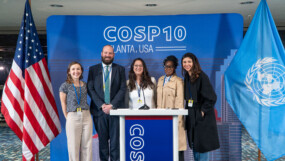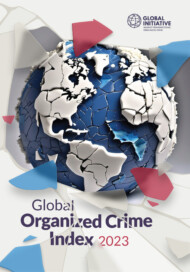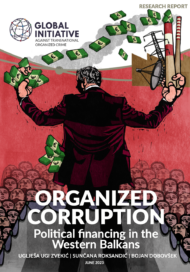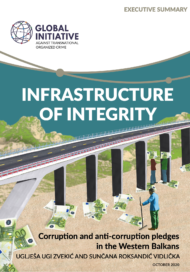Posted on 01 Dec 2023
Over the last three decades, organized crime has been allowed to grow within the cracks and evolve in step with the global economy and advancements in technology to levels hardly imaginable. In contrast, governments have been slow to respond to the threat that organized crime poses. A more concerted, adaptive approach to tackling criminal flows and corruption by policymakers, law enforcement agencies, and civil society and the media is needed.
The Global Organized Crime Index (ocindex.net) presents data that shows the kinds of contribution that non-state actors can make to the joint efforts against organized crime. The Index is designed to enrich the base of evidence and, thereby, to enable more effective policy responses. It is a macro snapshot of criminality and resilience to organized crime on a global scale. In this sense, it is like an x-ray of global criminality: it reveals where the issues lie, but without purporting to prescribe the remedy.
At the beginning of the 21st century, the concept of organized crime gained political and scientific legitimacy. This became evident in the fact that international organizations issued conventions and plans specifically designed to address organized crime. The most prominent and inclusive were the United Nations Convention against Transnational Organized Crime (2000) and its three protocols, and the United Nations Convention against Corruption (2003). But even with these legislative efforts on the part of policymakers, organized crime groups continue to conduct their affairs largely unhindered by the plans and strategies drawn up by politicians and law enforcement. One central challenge is that there has been a lack of a comprehensive understanding of the problem of organized crime and the dynamics of illicit economies. This knowledge gap is arguably a result of the way in which organized crime has swiftly adapted to a globalized, technological world economy, and the inability of those responsible for countering it to keep up.
This is why we produce the Global Organized Crime Index. Understanding a clandestine phenomenon such as organized crime is not an easy feat. Producing the Index requires the joint efforts of hundreds of experts from multiple disciplines to reveal the reach and complexities of transnational organized crime spanning many jurisdictions, and ensure global comparability. It also draws upon the broader granular work produced by the Global Initiative Against Transnational Organized Crime (GI-TOC). The purpose of the Index project is to provide a tool to analyze and compare data longitudinally, periodically, and by extension to catalyze a constructive dialogue on the issue of organized crime and modes of response. If we can understand the phenomenon, and measure it over time, then we can identify the most immediate threats and build adequate measures to mitigate them.
A central issue recognized in the Index is the role corruption plays in organized crime economies. This article looks at the intersections between criminality and corruption, as found in the Index, and proposes steps for states to address corruption.
The criminality and corruption intersection
A key feature of organized crime is its links to the state, enabled by corruption. Wherever organized crime exists, it seeks protection from interference from the criminal justice system. Large sums are spent by organized groups to garner political influence at local and national government levels by corrupting and colluding with officials. That the state itself is the criminal actor in some contexts is one reason why it has been difficult to counter organized crime in any effective way.
This is evident in the strong correlation (−0.84) between corruption, measured by the Corruption Perceptions Index (CPI), and the state-embedded actors’ scores in the 2023 Global Organized Crime Index. While corruption is not considered a standalone criminal market according to the methodology of the Index, it is nevertheless captured in all of its three subcomponents. For instance, corruption is considered an aggravating factor in the general score under the first subcomponent of the Index – criminal markets. Put simply, a criminal market characterized by a significant degree of corruption will score higher than one where corruption is less pervasive. Corruption also features in the criminal actors subcomponent, under the state-embedded actor typology. Although corruption is a prominent feature of the state-embedded actors category (the Index measures five types of criminal actors), it cuts across the other criminal actor categories, where the degree of criminal cooperation with members of the state apparatus is considered as a criterion in the assessment of criminal actors. Corruption is also central to the 12 resilience indicators assessed in the Index, where it is recognized as an impediment to the effective implementation of anti-organized crime measures and frameworks. Additionally, there is a corruption-focused indicator – ‘government transparency and accountability’ – which measures not only the perception of corruption within a country, but also the existence and efficacy of transparency and oversight mechanisms that act as a bulwark against corruption within state institutions.
The results of this second sweep of the Global Organized Crime Index show a very strong correlation (0.90) between overall resilience and perceived corruption, measured by the CPI. This link between corruption and resilience is confirmed when measuring the relationship between overall resilience and the World Justice Project’s absence of corruption scores, where the coefficient is positive, at 0.85. Although this correlation does not equate to causation – i.e. we cannot say for certain that corruption causes resilience to decline –reducing levels of corruption is very likely to bolster resilience.
And while corrupted state institutions play a role in facilitating criminal markets, bad apples in the public sector benefit from the financial and operational support of criminal groups. This murky partnership allows for a symbiotic relationship to thrive between the two, which, if left unchecked, can undermine the fabric of society. Some state officials not only protect criminal elements, but at times are actively involved in criminal markets. And here lies the difficulty in producing a rigorous response to the threat posed by organized crime: how are we to tackle organized crime effectively if state actors facilitate and perpetuate it?
There are two key vectors along which stakeholders – policymakers, law enforcement professionals and civil society – can build capacity. The 2023 Index expert assessments put ‘government transparency and accountability’ (4.36) as the second lowest-scoring resilience building block globally. This underscores the importance of greater access to public information – a hallmark of democracy. Targeted efforts in that direction would permit citizens to hold officials to a higher standard of accountability. While corruption risks permeating all echelons of power, it is not true that all institutions are corrupt. We should recognize state institutions that show integrity in their mandates. The first vector on which governments globally need to focus in order to better tackle corruption is encouraging increased transparency of the state apparatus. In an era defined by rapid growth of the cyber space, technology creates opportunities for criminal organizations to proliferate. But, at the same time, it enables state entities to improve their work of making bureaucratic processes more transparent. It is critical therefore that governments make use of that opportunity and foster a culture of transparency in public sector entities by taking the lead in implementing frameworks that contribute to a higher standard of openness and accountability.
Promoting better checks and balances by enabling grass-root organizations and independent media to function without interference is the second, but equally important, vector. One such example is the EU for Integrity Programme for the Eastern Partnership, which aims to enhance the assistance mechanism granted to individuals in their effort to reform the system and fight corruption. What the 2023 Index results show is that the environment non-state actors are allowed to operate in has deteriorated the most globally, declining by 0.16 points since the 2021 assessment. In many settings, journalists and members of civil society are vulnerable to political pressure and at the same time lack social and legal protection. Even in Europe – the continent where journalists and CSOs are less impeded in carrying out their work than in other regions (see the graph) – those who expose the wrongdoings of public officials are often targeted. This is evident in the increase of Strategic Lawsuits against Public Participation or SLAPPs. Information points to an almost 50% increase in SLAPPs in 2023 (820), compared to 2022 (570). Furthermore, abusive legal actions targeting certain individuals speak to the level of exposure of journalists and activists and the need for greater support.
The graph shows the percentage of countries on each continent that fall within the Index’s resilience bands for the non-state actors indicator.
The results of the 2023 Index make it evident that substantive participation of all stakeholders – intergovernmental, state and non-state – in the conversation around the evolving threats of organized crime is paramount. Only through a better, more coordinated approach will stakeholders be able to negate corrupt practices and, by extension, mitigate the harmful effects of organized crime on society, democracy and peace.
This analysis is part of the GI-TOC’s series of articles delving into the results of the Global Organized Crime Index 2021. The series explores the Index’s findings and their effects on policymaking, anti-organized crime measures and analyses from a thematic or regional perspective.



